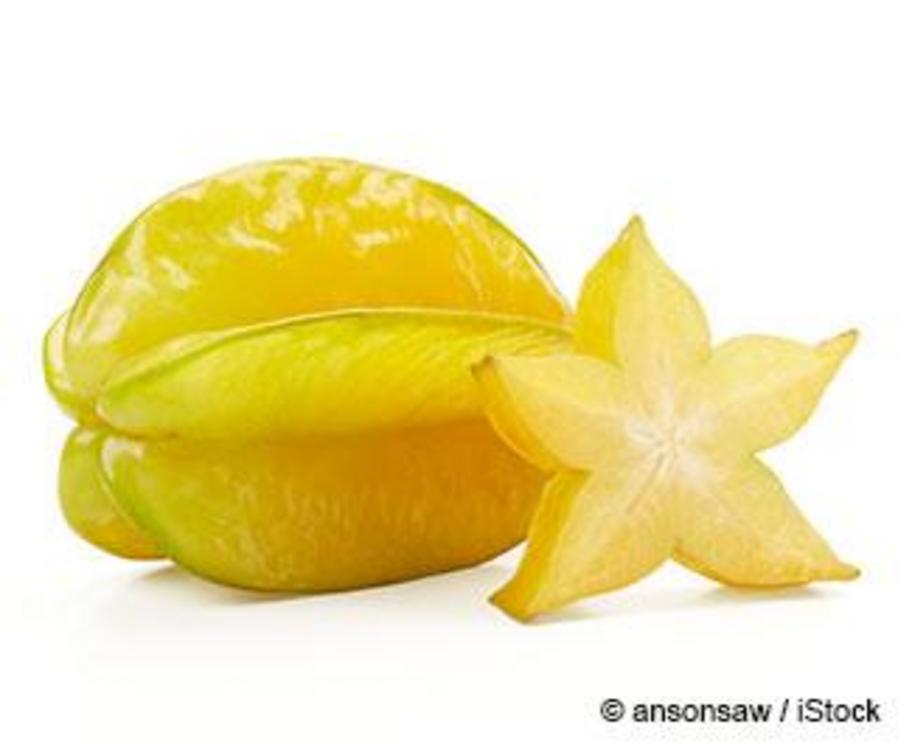How to eat star fruit
The five-angled star fruit, also known as carambola, is a waxy, yellow-green fruit that originated in the sultry, tropical area of Sri Lanka. The fruit grows on a small, bushy evergreen tree, first bearing clusters of small lilac, bell-shaped flowers which become the oblong fruits. Today, this lovely fruit is cultivated in Australia, South America, Hawaii, and Florida. Because they're known to be intolerant of cold and actually die in freezing weather, it's best to grow them in more moderate temperatures.
Obviously, the most unique visual quality of the star fruit is its shape - that of a perfect star when it's cut across the middle. There are two varieties; the challenge is telling them apart, which you'll want to do, because one is deliciously sweet – described as a cross between an apple and a grape – and the other puckeringly sour. As a general rule, the sweet type has thicker flesh. Some contain two to five tiny, edible seeds in the center of each angled cell.
One of the great benefits of star fruit is that the entire thing – waxy coat and all – can be enjoyed.
Besides the more common yellow variety, which may have touches of brown on the outer ridges (although there are several sweet types that are white) this is one fruit that can be purchased while it’s still green and set aside for a few days to ripen to perfection. If too ripe, however, the fruit turns yellow and develops brown spots. It refrigerates well, which is a good way to extend their shelf life. Uses for star fruit include juice drinks or blends, smoothies, salsa, chutney, and salads, although they're also good to eat as is, like an apple. Cooked, the tart varieties work well for imparting a uniquely tart zing to poultry, meat, and seafood dishes, and even cooked desserts. As a garnish, they're unrivaled.
Because they have a tendency to bruise, it's best to buy star fruits while they're firm, and handle with care.
Health Benefits of Star Fruit
It's comes as no surprise that the greatest amount of nutrients in star fruit is derived from vitamin C, providing 76 percent of the daily recommended value in a single one-cup serving.
The C content in star fruit helps ward off colds, flu, and any other type of infection. Science has shown that individuals in extreme arctic climates, such as military personnel, skiers, or researchers, experience a significant risk reduction – as much as 50 percent – for developing a cold when ingesting healthy amounts of vitamin C. Another reason vitamin C is called an essential vitamin is because it's needed by the body to form collagen in the bones, cartilage, muscle, blood vessels, and aids in the absorption of iron. Also, one of the most notorious consequences of a lack in vitamin C is scurvy, which early sailors discovered and remedied with all types of tropical fruits, including star fruit. Although it's rare, scurvy can have severe consequences, so treatment for patients with scurvy typically begins with vitamin C.
Smaller amounts of dietary fiber, copper, pantothenic acid, and potassium (which can prevent muscle cramps by increasing blood circulation) are important components of this fruit. B-complex vitamins like folates, riboflavin, and pyridoxine (Vitamin B6) are also present and team up to perform various synthetic functions inside the body, such as forming metabolizing enzymes.
The average star fruit contains around 30 calories (fewer than any other tropical fruit per serving), so with its high fiber content, it's a great choice for anyone wanting to lose weight, prevent constipation, and keep their system running smoothly. It also helps prevent the absorption of LDL ("bad") cholesterol while protecting the colon from toxic substances, by binding to cancer-causing chemicals that happen to be passing through.
The antioxidants offer their own benefits, including the neutralization of harmful free radicals that can cause inflammation. Flavonoids such as quercetin, epicatechin, and gallic acid offer this benefit, as well.
Traditional Brazilian folk medicine made use of star fruit as a diuretic, an expectorant, and cough suppressant. The leaves and fruit have been used to stop vomiting; placed on the temples to ease headache; for poultices to relieve chickenpox and rid the body of parasitic infestation. Powdered seeds reputedly have a sedative effect. However, dialysis patients or those with possible renal failure symptoms have reportedly developed neurological symptoms, and are advised to strictly avoid eating star fruit.
However, consume star fruits in moderation because they contain fructose, which may be harmful to your health in excessive amounts.
Starfruit Nutrition Facts

Studies on Star Fruit
Inhibitory effects of tropical fruits on midazolam hydroxylase activity of CYP3A (a major xenobiotic (a chemical compound such as a drug, pesticide, or carcinogen foreign to a living organism) metabolizing enzyme in human liver microsomes were evaluated. Eight tropical fruits – papaw, dragon fruit, kiwi fruit, mango, passion fruit, pomegranate, rambutan, and star fruit –were tested. The juice of star fruit showed the most potent inhibition of CYP3A. The addition of a star fruit juice in testing resulted in the almost complete inhibition of midazolam hydroxylase activity.1,2
Preliminary results of another extensive study supported the use of A. carambola (star fruit) as an anti-inflammatory agent and introduced new possibilities for its use in skin disorders. Star fruit was noted for being rich in antioxidants and polyphenolic compounds, which inhibit reactive oxygen species. O-glycosyl flavonoid components such as quercetin, rutin (a component in fruits shown to protect against heart attack and stroke) and cyanidin were identified, and insoluble fibers slowed the absorption of carbohydrates to significantly reduce blood glucose levels.
The fiber content of star fruit can help prevent cardiovascular disease by reducing serum triglyceride and total cholesterol levels. Selective activity against brain tumor cells also was observed, and an extract from the leaves was shown to be effective against liver carcinoma cells.3
How to Eat Star Fruit
Although you can combine star fruit in your favorite recipes, you can actually enjoy it by itself. This fruit is best eaten ripe, and you’ll know it’s ready through its vibrant yellow color. Star fruit may have some dark brown markings along the five ridges, but don’t worry because this is normal. Choose those that are still firm, not mushy, and do not have brown spots all over.
Whether you want to eat star fruit by itself or use it in your recipes, it’s important to learn how to slice it properly. Here’s what to do:
- Wash the fruit thoroughly using plain running water. Scrub it with your finger to ensure any loose dirt hiding in the crevices is removed.
- Using a sharp knife, cut the fruit across its broad side so that it is divided into star-shaped slices that are at least 1/4-inch to 1/2-inch wide.
You can remove the seeds and the brown edges, although these are also edible. Once you’ve properly sliced it, you can now eat and enjoy this fruit or use it as a healthy ingredient for recipes, such as the one below.

Star Fruit Soup
Ingredients:
2 chicken drumsticks
1 star fruit, sliced
1 teaspoon lemon grass
1 teaspoon kaffir lime leaves, shredded
4 ounces shallots, chopped
4 cups chicken stock
2 teaspoons small tomatoes
1 ounce fish sauce
1 ounce black soya sauce
1 ounce white soya sauce
2 teaspoons coriander, chopped
1 red chilli, shredded
Procedures:
- Place the chicken stock in a saucepan and boil the drumsticks until tender. Add black and white soya sauce to taste.
- Put sliced star fruit, shallots, tomatoes, lemon grass and shredded kaffir lime leaves in the pan and season
- To serve: pour into one large or two individual bowls and decorate with coriander and red chilli. Serve warm or hot.
(From Nikibone.com)
Star Fruit Fun Facts
A common citrus fruit in the Southeastern Asia and Pacific Island regions for centuries, star fruit dates as far back as the 2,000-year-old Silk Road trade route between China and Rome during the Tang Dynasty.
Summary
Hanging on the tree, they look like odd little lanterns. It's when you slice star fruits around the middle that they render the perfect star formation that is so fun to serve as a garnish or in salads with other succulent fruits. This exotic tropical fruit is also grown in the warmest areas of the U.S., and there are two main varieties that are sour and sweet.
But beyond its ability to render any salad more colorful and tasty, star fruit is packed with vitamin C as an infection fighter, plus antioxidants, flavonoids, copper, pantothenic acid, and potassium. Studies have shown it to be effective against such diseases as liver cancer and diabetes, with more studies continuing.
For full references please use source link below.

